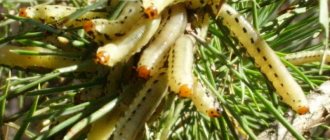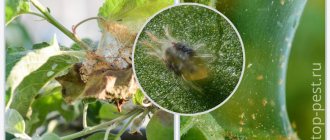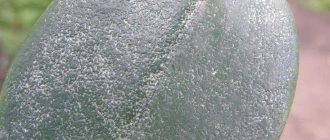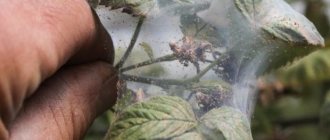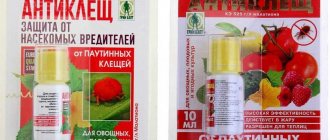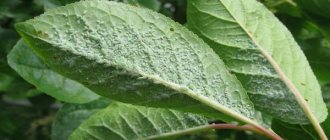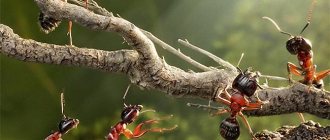Spider mites on seedlings can destroy the plant even before it has time to take root and bloom. The small insect loves warm weather and moderate humidity. It is especially active in the month of May, early June, when the first seedlings are planted in the garden. Peppers, eggplants, tomatoes, and cucumbers may be affected. Greenhouse conditions are more suitable for spider mites, but they freely parasitize in open ground.
Let's get to know the spider mite
Spider mites are the smallest insects, measuring less than 1 mm in adulthood. Without the help of a magnifying glass, a tick is visible only as a dot, but it causes a lot of damage. The adult tick is red or brown in color, the larvae are greenish.
The spider mite lives for about 1 month, but during this time it manages to breed over a large area. The laid eggs turn into larvae in 3-5 days, and it takes the same number of days for it to turn into an adult tick. In 1 day, a female spider mite can lay up to 450 eggs. Female ticks are very tenacious and often overwinter in the ground, and larvae can hatch from the eggs even after 5 years of preservation in the ground.
Attention. If you have removed all the plants from your garden, spider mites may hide in the ground for the winter.
Spider mites under a microscope
Chemicals against pests
Professional control measures include the use of insecticides, acaricides, and contact-intestinal preparations. The products are highly effective, kill spider mites in a few hours, and prevent re-infection for another 30 days.
Important!
The use of insecticides at the beginning of the growing season - at the seedling stage - is permitted without any special restrictions. In the future, the method should not be used during the flowering period of crops, 20 days before harvest. During work, be sure to use personal protective equipment - rubber gloves.
Among the disadvantages is high toxicity in the first days after treatment. The poison destroys not only spider mites and other pests, but also beneficial insects. It is somewhat more humane to use poison in a closed greenhouse.
Chemicals destroy larvae of different ages and adults, but do not affect eggs that are in the soil. To destroy the larvae immediately after hatching, it is recommended to spray the soil in the garden bed. In this case, the properties are retained for about 60 days.
How are spider mites harmful?
Spider mites settle on the reverse side of the leaf of a young garden crop, pierce a hole in the leaf with their proboscis, and suck all the juices out of it in this area, then move on to another place. After the mites have “worked”, a whitish marble pattern is formed on the sheet. There may be small thin white webs hanging from the leaf. The leaf then turns yellow and dries out.
Attention. Spider mites are also harmful because they carry gray rot spores.
How to prevent mass reproduction of spider mites?
To prevent spider mites from breeding over a large area, we take the following actions :
- We maintain air humidity in the greenhouse above 70%; moisture has a bad effect on mites, and at 80% they die.
- In the fall, we dig up the soil in the greenhouse, especially trying in the corners.
- We burn all the plants after they have been harvested.
- Spider mites reproduce well if the soil is saturated with potassium fertilizers - we add more phosphorus fertilizers.
- Ticks may remain on the frame and trellises - we disinfect them.
- We plant calendula bushes between the vegetables.
Causes of plant infection
Spider mites can destroy all plants grown in the country, in the greenhouse and in the house. He is very unpretentious and can live wherever he wants. Active reproduction is observed throughout the warm season. It overwinters in the upper layers of the soil, in fallen leaves and does not die in frost. Can be carried by wind.
Creating favorable conditions (fertilizing with nitrogen fertilizers, insufficient watering, temperatures above +25 ° C) promotes its active reproduction. It will not be possible to completely protect plants from infection, so it is necessary to carry out preventive measures and destroy diseased ones.
How can you kill spider mites?
Spider mites can be destroyed in the following ways:
- Pick off yellowed leaves and burn them if there are few such leaves.
- With the help of living creatures - enemies of spider mites
- Planting plants and vegetables next to vegetable crops whose smells repel spider mites: garlic, onions, wormwood, tomatoes, calendula
- If the leaves are not severely damaged by spider mites, then you can spray them with folk remedies
- We treat noticeably damaged plants with biological products or acaricides
Attention. Before spraying, do not forget to remove the cobwebs from the leaves, otherwise the solution will not get on the mites.
Using special medications at home
Gardeners advise treating plants with gentle agents in the fight against spider mites, but if they do not give the desired result, you need to use specialized preparations. In this case, it is worth spraying with Bitoxibacillin, Fitoverm or colloidal sulfur
When these options do not work, pay attention to a broad-spectrum acaricide solution - Actellica, Omite, Neoron, Sunmite, Talstar, Flumite, Fufanon. In particular, you can use drugs to combat spider mites on currants
Spider mites are a very dangerous pest that can lead to the death of seedlings. That is why it is recommended to carefully monitor your plants and immediately treat them with the necessary products when the first signs of disease appear. This will protect you from crop loss.
How to kill spider mites using living creatures?
Spider mites can also be fought with the help of their enemies. The worst enemies of spider mites are the following insects:
- Ladybugs and their larvae. An adult ladybug is on average up to 5 mm in size, and the larvae can reach 18 mm in length. These bugs live for about 1 year, rarely up to 2 years. In 1 day, a ladybug eats up to 40 spider mites, and over a lifetime, up to 800. Ladybug larvae are even more voracious; they eat up to 70 spider mites per day. Bugs overwinter under fallen leaves and in the cracks of houses.
Ladybug
Ladybug larva
- Predatory mites (Phytoseiulus, Amblyseius). Phytoseiulus is an adult spider less than 1 mm in size. The female lays eggs in a spider mite colony. In 1 day, a predatory mite eats 5 spider mites, and the larvae that hatch from the eggs eat 10-15 eggs of their enemy. To attract predatory mites to your garden, you need, in addition to the main crops, to plant plants that they like: dill, mustard, and an ornamental plant - phacelia. And in order for predatory mites to remain on your site next year, you need to create good conditions for them to winter: wrap thick tree branches with pieces of cloth, and they will live there.
Predatory mite Phytoseiulus, enlarged under a microscope
- Lacewings, another name for the lacewing, and their larvae. Insects with greenish transparent wings are up to 1.5 cm long. The entire family of lacewings got their name because of their convex, iridescent golden eyes. The larvae of the flyweed are especially voracious - they can eat up to 150 spider mites or aphids in 1 day. To survive the winter, lacewings hide under fallen leaves in the garden, in cracks in houses or in the attic.
Lacewings
- Hoverflies. These insects are a bit like wasps - they have the same yellow-black stripes on their backs, they prefer to sit on yellow flowers and feed on their nectar. The female hoverfly lays eggs near colonies of aphids or spider mites, then the hatched larvae eat these harmful insects. Hoverflies like the smell of cumin, parsley, cilantro, and plantain; by planting them between the rows of vegetable crops, we will save the vegetable harvest. For the winter, hoverflies burrow into loose soil under trees.
Hoverfly
- Earwigs, another name for earwigs. Their length is approximately 2 cm. These insects eat everything: both small moving insects from the animal world - spider mites, aphids, and plants - vegetables, fruits, leaves. They are nocturnal, and during the day they hide in dark, damp places.
Earwig
- Ground beetles. They can be small - up to 1 mm, or large - up to 10 cm in length. These beetles feed on small insects (aphids, spider mites) and plants. In agriculture, they are specially bred to destroy harmful insects and weeds.
Ground beetle
- Spiders. All spiders are predators; they eat various small insects, including spider mites.
Spider
In addition to the listed insects, vegetable pests are eaten by: birds, bats, frogs, hedgehogs and lizards.
How to detect
This variation has a color suitable for camouflage and is small in size. They blend in with the foliage, which helps them stay in the shadows for a long time and go unnoticed.
It is much easier to detect its presence by the symptoms of the foliage. If there are few of them on the bush, then the leaves are simply covered with white spots, but if there is a large arch, the plant is enveloped in an almost imperceptible web, hence the name mite.
You can verify this by looking at photos of the flowers on which it started. The females of these creatures die about a month after birth, but during this time, unfortunately, they can lay over a hundred eggs.
How to destroy spider mites using folk remedies?
Folk remedies are more suitable for prevention against spider mites or at the very beginning of their appearance. If mites have already infested all the plants, then acaricides need to be used.
Method 1. Hydrogen peroxide
- Take 2 tbsp. l. hydrogen peroxide 3% and 1 liter of water, mix.
- If it is about 20 degrees Celsius outside, we spray the plants in 3-4 doses, every 5-7 days.
- If the temperature is about 30 degrees Celsius, we spray the plants in 3-4 doses, every 3 days.
Method 2. Ammonia
- Take 1 tsp. ammonia and 1 liter of water, mix.
- If it is about 20 degrees Celsius outside, we spray the plants in 3-4 doses, every 5-7 days.
- If the temperature is about 30 degrees Celsius, we spray the plants in 3-4 doses, every 3 days.
Method 3. Turpentine
- We pour the turpentine into small jars and place it between the initially affected plants.
- We temporarily cover the plants along with the jars with film. The smell of turpentine will kill the parasites.
Method 4. Tobacco
- Sprinkle crushed tobacco into dust on vegetable leaves damaged at an early stage.
Method 5. Datura decoction
- Fill 1 kg of dried datura herb or 3 kg of fresh plant with water to cover the herb and boil over low heat for 3 hours.
- When the broth has cooled, strain it, dilute it with 10 liters of water, and spray the leaves of vegetables affected by spider mites.
Method 6. Datura infusion
- Pour 100 g of dry dope into 1 liter of water, let it sit for 1 day, then spray the plants with spider mites.
Method 7. Dandelion infusion
- Pour 0.5 kg of dandelion leaves into 10 liters of water, leave for 3-4 hours, and spray the plants with spider mites.
Method 8. Calendula infusion
- Pour 400 g of calendula flowers into 4 liters of water, leave for 5 days - the infusion is ready for use.
Method 9. Sorrel infusion
- Pour 300 g of sorrel roots into a bucket of water, leave for 5 hours, then you can spray the plants affected by spider mites.
Method 10. Yarrow decoction
- Pour boiling water over 500 g of dried yarrow herb and cover with a lid.
- When the broth has cooled, dilute it with 10 liters of water and spray the leaves of vegetables with spider mites.
Method 11. Infusion of onion and garlic peels
- Pour 200 g of onion and garlic peels into a bucket of water, leave for 1 day - and you can destroy spider mites.
Method 12. Garlic infusion
- Take 2 heads of garlic, chop it, add 1 liter of water, and leave for 5 days.
- Strain the infusion, pour in another 1 liter of water, and spray the vegetable plants that have spider mites.
Method 13. Mustard infusion
- Take 60 g of mustard powder, add 1 liter of water, leave for 3 days, and you can spray the plants.
Method 14. Laundry soap solution
- Grate 20 g of laundry soap, pour 1 liter of hot water into it, stir until the soap dissolves.
- We soak a napkin in the solution and wash the leaves of garden plants on both sides. Make sure that the soap solution does not get on the roots of the plant.
Attention. Spraying of plants should be carried out in the early morning or evening - in the sun the effect of the drug decreases.
Prevention
The main prerequisite for the appearance of spider mites is dry air, so high air humidity and regular spraying of the outer part of the plant is a good prevention of the occurrence and reproduction of the pest. However, high air humidity only helps with infections by true spider mites, while false spider mites, on the contrary, love it very much. However, practice shows that plants are most often attacked by true spider mites rather than false ones.
When spraying a plant, you must be very careful so that the water does not remain for a long time in the core of the plant and the grooves of the leaves, as this can very easily lead to rotting. You need to be especially careful in winter, since in low light conditions and low temperatures, water evaporates quite slowly. Completely immersing the plant in water is unlikely to help, since insects protect themselves with air bubbles that cover them when they come into contact with water.
Spider mite Olllli
How to destroy spider mites with biological products?
Biological products are made from microorganisms and plants. They are not harmful to humans, but they destroy spider mites. The following drugs have proven themselves to be effective:
- "Akarin"
- "Aktofit"
- "Agravertine"
- "Vertimek"
- "Kleschevit"
- "Fitoverm"
Attention. Spraying should be carried out 3-4 times, or even more, since all drugs do not affect eggs laid by the female, but only on adults and larvae. When the larvae hatch from the eggs, spraying must be repeated.
All biological products do not act immediately, but after 8-12 hours. The drug must be diluted as written in the instructions on the package.
Attention. If you spray plants against spider mites several times a season, the preparations need to be changed, since the next generations of mites adapt to the poison and it does not affect them.
Signs of plant damage
Experts call the spider mite an ideal pest. It is capable of reproducing very quickly, is omnivorous, and at the same time easily goes into diapause if conditions are not too favorable for life. Clutches left by the female and covered with cobwebs can be found on the walls of containers, on the leaves below, as well as in the ground itself. The eggs have a smooth shell. They can remain viable for several years, without dying due to unfavorable conditions, but simply slowing down their development.
If the damage is very severe, the plant will be noticeably shrouded in such a net that collects dust and excrement of these small animals. However, some varieties of the pest practically do not weave webs
Another sign of infection are eggs, but it should be noted that they are very difficult to see. The fact is that the diameter of each is less than a millimeter, in addition, they are very light or even translucent. They are located in small groups, from 1 to 3 eggs in each, and are covered with a protective layer of cobwebs, creating the most suitable conditions for development. It takes 3 days for the larvae to appear.
This mite eats plant sap. He can get it from anywhere in the flower. Small light spots appear on the affected area; they are best seen on the leaves. This leads to a slowdown in photosynthesis and disruption of intercellular structures, respectively, their proper functioning becomes impossible.
These spots grow over time and lead to yellowing of the leaves. They dry out in small areas and also become sluggish and inelastic. A coating of cobwebs forms on top.
Finally, the last stage can be called the falling of leaves. The spots on their surface join together, the leaf blade dries out and falls off. The more pests there are on a plant, the faster they can destroy it.
How to kill spider mites with acaricides?
In addition to crawling spider mites, acaricides also destroy eggs. And yet, at one time, these chemicals cannot destroy all mites, but only 50-70%, the second time - close to 90%, the third time - the remaining ones. If it is cool, we re-process vegetable bushes after 4-6 days, if it is hot, then earlier. The best acaricides:
- «Apollo"
- "Nisoran"
- "Oberon"
- "Sunmite"
- "Flumite"
- "Floromite"
Attention. Acaricides are toxic agents that are harmful to people, so they should be used last if other methods do not help.
So, now we know how to destroy spider mites if they appear in your garden.
Reasons for the appearance of ticks on the site
The common spider mite parasitizes not only tomatoes in a greenhouse or open ground. More than 200 species of cultivated plants serve as food supply for it.
Where does it winter
Fertilized female spider mites are able to withstand temperatures down to -28° C, and overwinter in open ground, on plant debris that is not harvested at the end of the season, under the bark of trees. Especially many of them survive in greenhouses if sanitation was not carried out in the fall or was done poorly.
As soon as the temperature rises to 12 ° C, female spider mites come out of hiding and lay fertilized eggs, from which individuals of both sexes hatch. In spring, arachnids colonize weeds in the ground, where the first generations develop. Then they move to trees, garden and ornamental plants.
Fertilization is not necessary for eggs to hatch into adults. It’s just that if males did not participate in reproduction, only males hatch. The first clutch consists exclusively of fertilized eggs.
How it spreads
In greenhouses in the spring, spider mites feel especially comfortable on tomato seedlings. The leaves of newly planted plants lose turgor and are easy to bite through for microscopic arachnids.
Even if the area is clean, the soil and greenhouse have been treated from pests since the fall, this will only delay the appearance of spider mites. It is carried by the wind, animals, birds, insects, and enters the area by sticking to a person’s shoes or clothing. And only then it spreads with every fallen or torn infected leaf, on dirty hands or tools.
Favorable conditions
Depending on the climate, 8-18 generations appear per season. Greenhouse conditions are especially favorable for the spread of mites. The maximum number of generations develops there.
At first, spider mites are controlled by low temperatures and high humidity (if it rains in the spring). The population grows slowly, although each female lays 150 eggs at a time on the underside of the leaves, first entwined with a thin web.
The full development cycle - from laying to an adult sexually mature individual (imago) of a tick lasts 8-20 days. The higher the temperature, the faster a new generation appears.
As soon as the thermometer shows 29–31° C, and the humidity drops to 35–55% due to the heat, the pest begins to develop rapidly. In southern gardens it often attacks tomatoes in the summer, especially in the absence of rain. In greenhouses, the arachnid feels at ease, regardless of the region, and manifests itself much earlier than in open ground.
The spread is facilitated by low humidity, high temperature, lack of preventive treatments and unsanitary conditions.
Video: Spider mite. How to quickly and reliably defeat a pest?
Let's learn more about growing and diseases of vegetables:
- What should not be fed with ash?
- There is one barren flower on cucumbers in the open ground, in a greenhouse: why, what to do
- Arugula - cultivation and care, pest control
- How to grow hot chili peppers on a windowsill at home
- Perennial onion - growing from seeds through seedlings and in open ground
